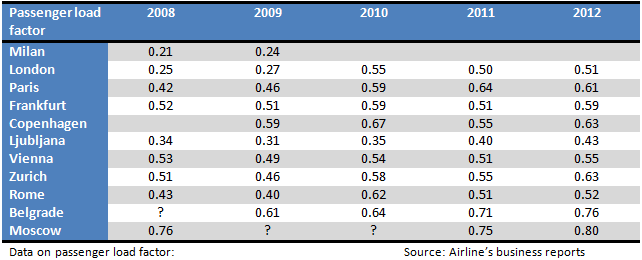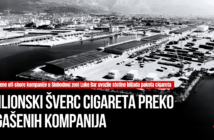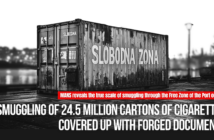Files of MONTENEGRO AIRLINES – DOOMED FLIGHT bring forth a series of accounts which testify how the state-owned company was systematically destroyed while being funded from the state budget in order to artificially maintain the monopoly in the “Montenegrin skies”. The files reveal how politicization of the administration, absence of individual responsibility and attitudes towards company’s resources turned Montenegro Airlines into an expensive toy on the verge of collapse. The tomorrow’s sequel provides the responses of the present and former management concerning MA operations.
Unfavorable conditions on the market and the crisis in the airline industry have not prevented neither the management of Montenegro Airlines (MA), nor the government, from conducting the megalomaniac politics of introducing unprofitable routes, such as those to Milan and London, and from increasing the size of the airline’s fleet, which has led to operating losses. This is confirmed by the MANS Investigation Center and “Vijesti” analysis, which is based on official documents.
The new routes were estimated to bring more tourists to Montenegro.
In the Information on opening new routes, adopted in 2010 by the government’s Commission for Economic Policy, it was stated that by introducing the routes, MA believed it would take over a big part of risk, since increasing the number of flights and opening new routes “is a great investment in times of economic crisis, decline of passengers’ purchase power, rise in fuel prices and huge competition in the airline market.” Finally, as it was stated, they approved the project of opening new routes as well as increasing the number of flights on the existing ones.
It was confirmed that flights to Milan were running in the period between July 2008 and February 2009, with averagely 25 passengers per flight, but due to ”low passenger load factor and poor financial results, it proved to be unsustainable”.
At the close of 2014, the airline showed uncovered loss of €40.5 million, whereas the loss for the current year stood at €9.5 million, which made the total loss reach €50 million. The report for 2015 has not been published yet, but the company’s unofficial estimate says that for the year in question the company’s loss was around €10.2 million.
In 2009, the uncovered loss was €700,000, in 2010 it grew to €4.6 million, a year later it rose to €8.3 million, whereas in 2012 it reached €14.8 million. In 2013, it was €35.3 million and in 2014 it reached the sum of €40.5 million.
Until 2007 MA fleet had five Fokker aircraft – four owned by the airline and one leased, with the average age of 14 and 18 years. The then MA management pointed out some additional weaknesses of Fokker aircraft, such as they had been designed for short flights and had had limited cargo space, which caused problems during the summer season.
In 2007, the MA management decided to choose another type of aircraft – Embraer, on the grounds of winning distant markets, such as Russian, British and Scandinavian. The management emphasized that, unlike the Fokker, those aircraft were designed for long flights, were faster and had higher payload, whereas there were no limits when in terms of cargo space, and their maintenance was significantly cheaper, as well as the fuel.
In mid-2007, an agreement on leasing two Embraer aircraft for a period of two years was signed, with planned delivery over the following two years. In November 2007, the government adopted the Restructuring Strategy of MA, where it was announced that the management planned to purchase two more Embraer aircraft. The government, which owned almost 100 percent of shares in the airline, approved and gave the green light for privatization of the company through recapitalization, through which part of the funds for purchasing new aircraft would be provided.
In the Restructuring Strategy, it is stated that there is no “quality in short-term or long-term financing, the company’s current liquidity is not being preserved nor are there conditions for preserving the current liquidity”. The most favorable model of financial restructuring is recapitalization through issuing new shares without endangering the position of the majority owner, but securing reliable and permanent sources of funds, development of cooperative environment and attracting strategic partners.
The MA management did not wait to see the outcome of the privatization process, to make sure the amount of money for aircraft purchase is secured, but in May 2008, supported by the government, it decided to open two new routes – to London and Milan (with at least two flight rotations per week), to increase the number of flights to Paris (third rotation) and introduce daily flights to Frankfurt.
As the main reason for opening new routes, the management of MA stated the fact that the market of Great Britain was interesting to Montenegro and that London airports were the largest transit points in the world. According to their estimate, 55 percent of passengers would be tourists, 15 percent transit passengers and 30 percent local passengers, owing to which the flight to London could become “potentially profitable” in near future. However, the management pointed out that many competitive airlines operated flights to London, with cheap tickets for tourists.
Even though MA operated flights to Rome, it was decided to introduce a route to Milano, on the grounds that ”the area in the vicinity of Milano is one of economically most developed regions of Europe, and Montenegro, as well as the airline, has a strong need to position itself in such important economic and transport center.”
Introduction the third weekly rotation to Paris was justified on the basis of attracting more tourists from France, as well as on the basis of high speed train route to Brussels and Strasbourg, which would be important for civil servants who travel from Montenegro to EU for business. Daily flights to Frankfurt were proposed since it is one of the main transit points to Montenegro.
In mid-2008, the management of MA estimated that opening new routes and increasing the number of flights on the existing routes would bring 35,000 passengers to Montenegro, and the state would earn indirect revenues of €26.8 million from tourism. At the same time, the management requested state aid for opening the new routes. The government granted €1.6 million by signing agreement on purchasing a certain number of airline tickets at the fixed price for flights to Paris, London, Frankfurt and Milan (business class).
Concurrently with establishing new routes to London and Milan, in summer 2008, the national airline took delivery of the first Embraer 195. That same year, the government approved the purchase of Embraer aircraft using the financing model under which MA was obliged to pay 15 percent of the value of the aircraft ($4.7 million), whereas the remaining 85 percent of the value of the aircraft value would be provided through recapitalization and commercial loans.
Yet, out of the planned deposit of $4.7 million, MA managed to pay only $1.4 million by March next year, and asked the government to extend the deadline for Embraer delivery, i.e. till June 2010. They were given the consent for signing the annexes to the sales and purchase agreement. The official data show that by extending the delivery deadline the price of the aircraft increased by €480,000, whereas due to the strengthening of the dollar against the euro, the price additionally rose by €4.5 million.
Apart from the request to postpone the delivery, MA demanded from the government to find a partner which would take over sales and purchase agreement from Embraer, and the Montenegrin airline would lease it afterwards. This plan was realized since the Cayman island-based company Montenegro Aviation Leasing Limited emerged as a buyer. This Embraer was delivered in June 2010.
The fourth, leased Embraer aircraft (original plan was its purchase, but the plan was abandoned later) has been in the airline fleet since May 2014, but does not have as strong technical characteristics as three leased aircraft. According to the official data found on MA website from May 2016, the fleet consists of four Embraer aircraft (three 195 and one 190) and two Fokker aircraft which are operational.
MA business reports show that the flights to Milan were operating only in 2008 and 2009 and had an average passenger load factor of 0.23 percent (aircraft was filled less than one quarter). During those two years, the route to London had passenger load factor of 0.25 percent, and in the period between 2010 until the close of 2012 this figure was below 0.50 percent (which means that half of seats were empty). The data for the last three years are not available, whereas MA has not published the financial result concerning this route.
When it comes to the route to Paris, which is regarded as one of the more distant and expensive destinations, an average passenger load factor in 2008 and 2009 was 0.45 percent, and at the close of 2012 it was 0.61 percent. The data for the last three years are not available.
The passenger load factor on the Frankfurt route is around 0.60 percent on average, and since 2009, MA introduced another route for a long-distance destination – Copenhagen, which was opened because of Montenegrin diaspora in north European countries. The average passenger load factor for these destinations is 0.60 per cent.
MA has been operating flights to Ljubljana for years, despite the low passenger load factor of 0.50. The airline’s data show that by the end of 2012, passenger load factors on flights to Belgrade and Moscow were the highest, 0.80 per cent and 0.76 per cent, on average.
Aircraft lease costs rise, unfavorable dollar to euro exchange rate
The accurate data under what conditions MA purchased and leased the Embraer aircraft are not available. The Investigation Center, pursuant to the Law on Free Access to Information, asked MA to submit all aircraft lease agreements, but failed to receive them on the grounds that those documents were confidential, and could not be disclosed by a contracting party to any third party without prior written consent of the other contracting party.
The price of $31.2 million was mentioned in the government’s Information from September 2008, by which it approved the purchase of the Embraer aircraft. Meanwhile, the Cayman island-based company Montenegro Aviation Leasing Limited purchased the sales and purchase agreement, whereas MA took Embraer through financial leasing. The audit report for 2014 states that the overall cost of the aircraft purchase was $47.7 million.
The data on value of the signed agreements on the basis of the operating loan for three Embraer aircraft are not publicly available nor accurate. However, MA business reports for 2014 show that annual costs for leasing the aircraft were around €5.5 million.
By the end of May of the same year, the fleet had one aircraft less, and the exchange rate between the dollar and euro was poorer. According to the unofficial data, at the close of 2015, monthly installments for three aircraft were €735,000, i.e. €9 million plus €3.8 million for the fourth Embraer. Thus, around €12 million went for leasing per year, without maintenance costs.
In 2007, the lease costs were €1 million, and only a year later they reached €2.8 million, whereas since 2009 MA has been setting aside 5.5 million on average for the aircraft lease. Maintenance costs, amounting to €5 million on average, were massive expenditures on annual basis for the airline.
The major expenditures of MA arise from fuel and energy costs, which were €15.9 million at the close of 2014, whereas in the last couple of years they reached the sum of €20 million ((in 2013 they were €19.2 million, in 2012 they reached €21.1 million, €20 million in 2011 and €18 million in 2010).
Debts bigger, government still pumps into MA
The MA management, headed by Daliborka Pejovic, has not replied to the questions regarding the company’s business operations asked by Vijesti.
The Information on priority obligations of the company to which Vijesti has recently had access to, drafted by the Ministry of Transport, headed by Ivan Brajovic, states that the MA debts have stood at €71 million on 21 January this year.
In mid-May this year, the government approved a loan of half a million to this company, where salaries are overdue, but it has not been officially published, nor is it clear on which legal basis it was done.
The total debt to suppliers is €31.2 million, out of which €12.3 million is already due. The debt owed to banks is €10.1 million, of which €3.8 million is due. MA owes €18.8 million to the Brazilian bank BNDES for the purchase of Embraer aircraft, whereas two installments totaling €3.7 million are due this year. It is stated that the debt to the Tax Administration is € 11.4 million, including the earnings for October earnings.
Through this Information a guarantee of €1 million for the purchase of fuel from Jugopetrol is required, as well as taking over payment of two installments amounting €3.7 million to the Brazilian bank. MA already owes €1.5 million to Jugopetrol, and the full amount is due.
The debts to Aerodromi Crne Gore, arising from various grounds, stand at €13.2 million, of which €5 million is due for payment, while for €8.1 million there is an agreement on the basis of enforceable judicial decision. A debt to the Belgrade Airport is €1.5 million, €379,000 of which is due for payment. The company owes €9.4 million to the Agency for Flight Control, of which €742,000 is due.
Debts arising from aircraft leasing in the earlier period amounted to €2.5 million and €2 million is due for payment. MA owes a total of €2 million for spare parts, insurance and to Eurocontrol, out of which €1.7 is due.
The report has suggested that the Ministry of Finance and the Ministry of Transport negotiate with the competent authorities of the European Commission about the extension of the deadline for implementation of the measures defined in the MA Restructuring Program and defining new measures.
The government adopted this program in 2012 and it expired last year. The Stabilization and Association Agreement was signed in 2010 and, among other things, specifies that state aid may be granted once in ten years.
Ines Mrdovic
Ivana Gudovic
This text is created with the support of the European Union within the project “Zero Tolerance to Corruption”. Network for Affirmation of Non-Governmental Sector – MANS is solely responsible for the contents of this article, and the views taken herein shall not in any case be considered as those of the European Union.
Former management: The benefit derived from MA is higher, we connected Montenegro with Europe and the world
From 2008, when the first aircraft was procured, until June 2013, about $50 million from the company’s funds was allocated for the fleet, and the government did not take part in this with taxpayers’ money. In 2007, the government granted a subsidy worth €1.7 million to the airlines for aircraft fuel, and in 2003, €3.2 million was allocated for the checkup of Fokker aircraft engine. Loan guaranty is a form of the state aid, but spending taxpayers’ money would mean that the loan for which the state provided a guarantee is not repaid in a timely manner, and MA repaid all the loans on time. This was the response “Vijesti” received from the former MA management, chaired by Zoran Djurisic.
When asked about the official data related to the substantial funds the state channeled into MA survival and what it received in return from the company, the company answered that by establishing and developing MA the state got a modern fleet of 9 aircraft. “MA has indirectly contributed to the Montenegrin GDP with more than €1 billion, since its establishment in 1994. MA recorded an annual turnover of €70-80 million (from 2008 to 2013, logically, turnover was not that high earlier), and has connected Montenegro with Europe and the world “, the former management pointed out and stated that just before the old management structure was replaced, an independent news agency Anatolia proclaimed MA as the best and most stable airline company in the ex-Yugoslav region.
They were asked who contributed to the fact that the company’s data on business activities showed that it was on the verge of bankruptcy, or what had almost thrown the company into bankruptcy and if the former management felt responsible. They said they felt no responsibility in relation to the state of affairs in the company, there was no talk of bankruptcy while they had been in charge of MA, until June 2013, and that the accumulated loss over 19 year of their management stood at €19.2 million, which was substantially less than losses of regional companies in the airline industry. They pointed out that in order to fully stabilize the company, it was urgent to restructure the company which would have six modern aircraft, about 300 employees and would operate without losses.
They stated that at the close of 2012 MA had a loss of €4.2 million, in the first five month of 2013 the company earned €1.6 million more than in the same period 2012 ”and we do not want to comment events after June 2013” but at the close of 2013 “the official loss was €5.2 million and in 2014 the loss stood at €9.5 million, whereas in 2015 it was €10.2 million.” They added that ”the experience shows that the first five months of 2016 will bring forth at least a six-million loss.“ They pointed out that in the last three years MA loss stood at €31 million, whereas the additional “sum of €10 million from taxpayers was spent, making the total loss of €41 million in comparison with €19.2 million which were accumulated over 19 years.”
When asked whether it was true that they had left the debt of €71 million, as claimed by the present management, they added that “rapid substantial changes in the amount of the debt can be described as irrational, at least.” According to them, the debt structure which is publicly available is questionable since “the greatest part of the debt arises from the arrangement with BNDES concerning the financial leasing for aircraft purchase,” which is to be repaid until 2022, and is not due now, as well as from Aerodromi in the period from 2009 to 2011, explaining that in the said period all companies sustained tremendous losses due to the hefty price of fuel, and that MA found these services expensive.
They were asked to which extent the lease payments for the aircraft and finance lease as well as currency movements, i.e. a decline of the euro against the dollar contributed to the negative financial result. They replied that the decline of the euro had been followed by the significant drop in prices of aviation fuel, and “a positive effect of hefty fuel prices was much more powerful than the negative, which was caused by currency movements.” They noted that the company’s expenses had increased, but simultaneously the revenues had gone up, “so given the conditions, the company was stable”. They also added that the state aid at the certain point of time was not an unknown scenario when it comes to the world’s giant companies.
When asked if the smarter policy of introducing new routes could be more profitable, such as the route to Milan, which was closed since it had proved to be unprofitable, they replied that opening new routes by national carriers, especially in developing countries, was not directly linked to financial benefit that this route could bring for a short time. ”In particular, the route to Milan was opened on the basis of the government’s initiative. At the same time, the route to Munich was also discussed, which was never introduced because MA estimated that it could have damaging effects. Analysis showed that the route to Milan was not sustainable without the direct assistance of the owner through some form of financing,” the former management replied, claiming that the timely closure resulted in savings for both the company and the owner. As examples of smart policy they mentioned the routes to Moscow, St. Petersburg, Rome, Vienna, and the improvements concerning the route to Paris.
When asked if MA had to lease the fourth Embraer, which was delivered in May 2014 and if it was more cost effective to invest that money in the fleet, they responded with a comparative analysis of Fokker and Embraer, in favor of Embraer. They found that each of 5 (6) aircraft is “necessary and is not a burden but a necessity.” When asked why they considered that most of the Restructuring Program from March 2012 had not been fulfilled, they responded that they had managed to receive state aid, but had failed to implement them fully for “known reasons”, adding that the Program was in accordance with law and was approved by the European Commission. “Direct government subsidies or allocating money from the budget began in the fall of 2013, when the new management of the company was appointed. We are not aware why they have failed to implement all the measures, ” the former management claims.




